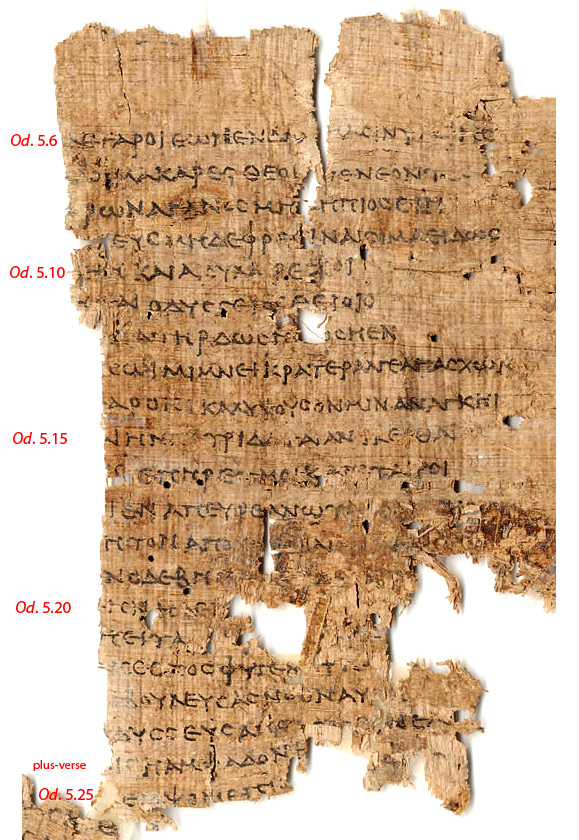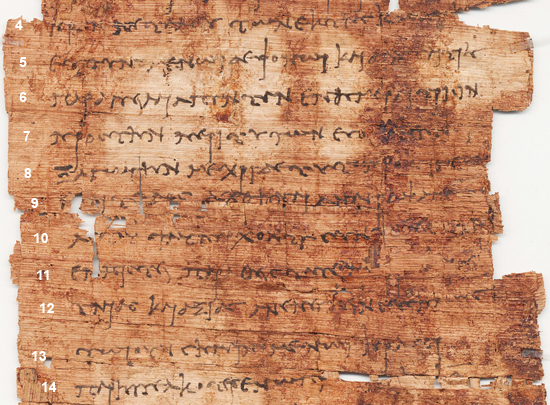

The papyri owned by the Berkeley campus are stored at The Bancroft Library in the care of the Center for the Tebtunis Papyri. Many on-line images are available through the database searchable at the Center's web site.
Here is an image showing part of one column of a papyrus roll of the 2nd century BCE containing Books 4-5 of Homer's Odyssey. The fragments of this roll are referred to as PTebt 697 (Tebtunis Papyri 697). The script is a "bookhand," that is, a careful and formal style with separation of individual letters and many rectilinear strokes, despite the emergence of curved letter forms suitable to writing with a pen on papyrus (note the lunate sigma, the epsilon of lunate form, the slight curvature of the right side of eta, the upward-opening omega).

Here is a transcription of the remains of the first 10 lines (partial letters are shown as complete), with the full line in the style of a modern edition below each line. There are discrepancies in the wording in 5.8, 5.11, 5.13, 5.14
Od. 5.6 ]ΛΕΓΑΡΟΙΕΩΝΕΝΔΩΜΑϹΙΝΥΜΦΗϹ
μνησαμένη· μέλε γάρ οἱ ἐὼν ἐν δώμασι νύμφης·
Od. 5.7 ]ΛΟΙΜΑΚΑΡΕϹΘΕΟΙ[Α]ΙΕΝΕΟΝΤΕϹ
Ζεῦ πάτερ ἠδ’ ἄλλοι μάκαρες θεοὶ αἰὲν ἐόντες,
Od. 5.8 ]ΟΦΡΩΝΑΓΑΝΟϹΜΗΔΗΠΙΟϹΕΙΗ
μή τις ἔτι πρόφρων ἀγανὸς καὶ ἤπιος ἔστω
Od. 5.9 ]ΙΛΕΥϹΜΗΔΕΦΡΕϹΙΝΑΙϹΙΜΑΕΙΔΩϹ
σκηπτοῦχος βασιλεύς, μηδὲ φρεσὶν αἴσιμα εἰδώς,
Od. 5.10 ]ΕΙΗΚΑΙΑΙϹΥΛΑΡΕΖΟΙ
ἀλλ’ αἰεὶ χαλεπός τ’ εἴη καὶ αἴσυλα ῥέζοι,
Od. 5.11 ]ΗΤΑΙΟΔΥϹϹΕΙΟϹΘΕΙΟΙΟ
ὡς οὔ τις μέμνηται Ὀδυσσῆος θείοιο
Od. 5.12 ]ΠΑΤΗΡΔΩϹΗΠΙΟϹΗΕΝ
λαῶν, οἷσιν ἄνασσε, πατὴρ δ’ ὣς ἤπιος ἦεν.
Od. 5.13 ]ϹΩΙΜΙΜΝΕΙΚΡΑΤΕΡΑΛΓΕΑΠΑϹΧΩΝ
ἀλλ’ ὁ μὲν ἐν νήσῳ κεῖται κρατέρ’ ἄλγεα πάσχων,
Od. 5.14 ]ΓΑΡΟΙϹΙΚΑΛΥΨΟΥϹΟΝΜΙΝΑΝΑΓΚΗΙ
νύμφης ἐν μεγάροισι Καλυψοῦς, ἥ μιν ἀνάγκῃ
Od. 5.15 ]ΑΙΗΝΠΑΤΡΙΔΑΓΑΙΑΝΙΚΕ[Ϲ]ΘΑΙ
ἴσχει· ὁ δ’ οὐ δύναται ἣν πατρίδα γαῖαν ἱκέσθαι·
Most of the Greek papyri in the Berkeley collection are "documentary" rather than literary. They contain accounts, contracts, personal letters, and the like. They are often written in a much more cursive (and sometimes irregular) script than the bookhand illustrated above. The example here shows lines 4-14 of P.Tebt. 14, a draft of an official letter from Menches, village scribe of Kerkeosiris, Egypt, to Horos, royal scribe of Kerkeosiris, written in November 114 BCE. Menches' cursive is quite uniform and professional, but quite a bit harder to decipher than a bookhand. Notice the continuation of strokes from letter to letter, the simplification of the loop of alpha, the cursive forms of upsilon and eta, the epsilon-iota ligature (line 6).

4: Ἡρᾶτι Πετάλου τῶν ἐκ τῆς κώμης
5: εὐθυνομένωι δὲ φόνωι καὶ ἄλλαις αἰτίας
6: παραγγεῖλαι ἀπαντᾶν ἐν ἡμέραι τρισὶν
7: πρὸς τὴν περὶ τούτων ἐσομένην διε-
8: ξαγωγήν, μέχρι δὲ τοῦ τὸ προκείμενον
9: ἐπὶ τέλος ἀχθῆναι ἀναγραψάμεν̣ο̣ς̣
10: αὐτοῦ τὰ ὑπάρχοντα συντάξαι θεῖναι
11: ἐν πίστει παραθεὶς τά τε μ[έτ]ρ[α] καὶ γει-
12: τνίας καὶ ἀξίας ἀνενεγκεῖν εὐσήμως.
13: τῶι οὖν σημαινομένωι Ἡρᾶτ̣ι
14: παρηγγελκότες ἐνώπι[ον] τῆ[ι]